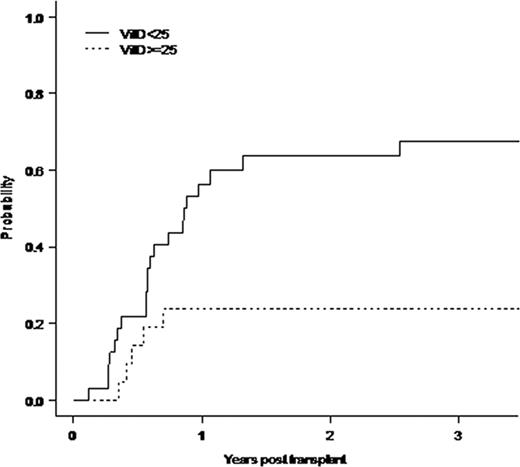Abstract
Abstract 4063
Graft-versus-host disease (GVHD) remains a significant cause of morbidity and mortality following allogeneic hematopoietic stem cell transplantation. GVHD is mediated by the activation and expansion of donor derived alloreactive lymphocytes stimulated in part by residual host dendritic cells (DCs) and donor DCs with cross presentation of alloantigens. Vitamin D is a hormone essential for calcium homeostasis and exhibits potent immunomodulatory characteristics. We have demonstrated that vitamin D exposure inhibits DC maturation and DC mediated stimulation of allogeneic T cells. As such, we hypothesized that vitamin D deficiency may result in the enhanced capacity of DCs to induce GVHD. In this study, we performed a retrospective case-control study to evaluate whether monohydroxyvitamin D levels measured in serum samples obtained from patients prior to allogeneic transplantation were predictive of the risk for GVHD. Fifty-three patients aged 18–60 who underwent a myeloablative matched related or matched unrelated donor transplant between December 2000 and December 2009 at Dana Farber Cancer Institute (DFCI) were included in the analysis. 25-OH vitamin D concentrations were measured by an ELISA assay on serum samples that had been cryopreserved between one and three months prior to transplantation. All patients were alive and evaluable at day 100. The median 25-OH vitamin D level was 21.9 ng/mL (range 7.8–45.7). Patients were divided into two cohorts based on a vitamin D level: < 25 ng/mL (32 patients) or ≥25 ng/mL (21 patients). There was no difference between the groups with respect to patient or donor age, donor type (matched related versus unrelated donor), cell source (peripheral blood versus bone marrow), patient-donor sex matching, myeloid versus lymphoid malignancy, risk status, patient/donor CMV status, conditioning regimen, or GVHD prophylaxis regimen. The cumulative incidence of grades II-IV acute GVHD at 100 days was 53.1% in the group with vitamin D level <25 versus 33.3% in the group with vitamin D≥25 (p=0.13). Remarkably, the cumulative incidence (CI) of chronic GVHD (cGVHD) at 2 years in patients with 25-OH vitamin D <25 was 63.8%, compared to 23.8% in patients with vitamin D levels ≥ 25 (p=0.009). Similarly the 2 year CI of extensive cGVHD was significantly greater in patients with vitamin D levels <25 compared to those with ≥25 (54.5% versus 14.3%, p=0.005). This result is consistent in multivariable competing risks model for which patient and transplant related factors mentioned above were adjusted (HR 5.26, p=0.02). Figure 1 represents the CI of cGVHD with death and relapse as a competing risk. Three-year progression-free survival and overall survival were similar between the two groups (51% vs. 47%, p=0.61; and 53% vs. 50%, p=0.57 respectively). In summary, vitamin D deficiency prior to allogeneic transplantation is associated with a significantly increased risk of chronic GVHD. A prospective clinical trial evaluating the use of vitamin D for the prevention of chronic GVHD is planned.
Figure 1:
Cumulative Incidence of cGVHD with Death/Relapse as a Competing Risk
Disclosures:
No relevant conflicts of interest to declare.
Author notes
*
Asterisk with author names denotes non-ASH members.
© 2011 by The American Society of Hematology
2011


This feature is available to Subscribers Only
Sign In or Create an Account Close Modal